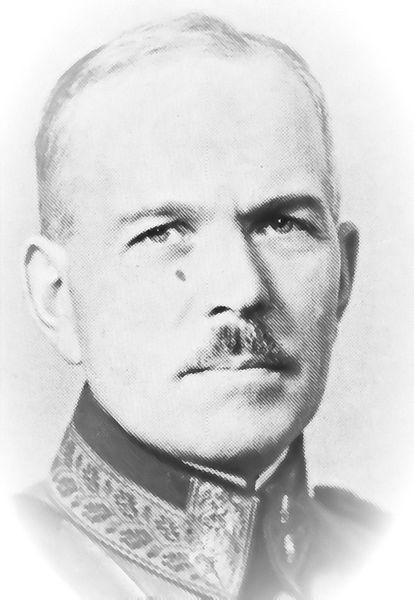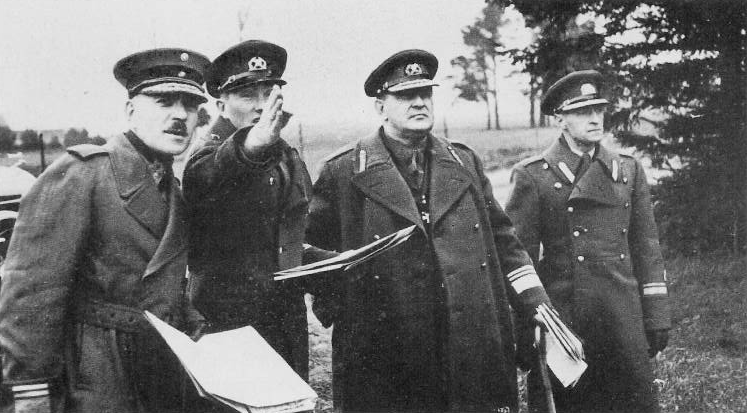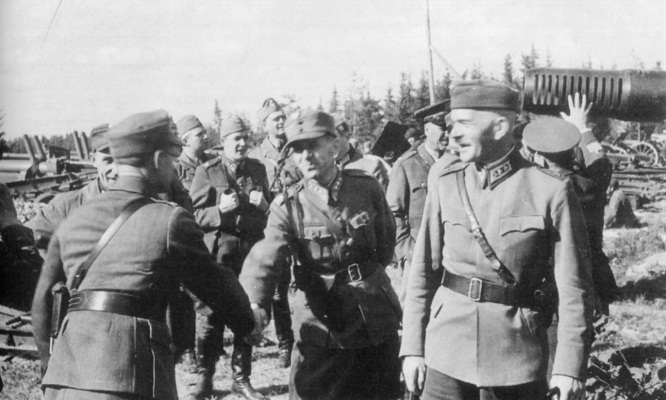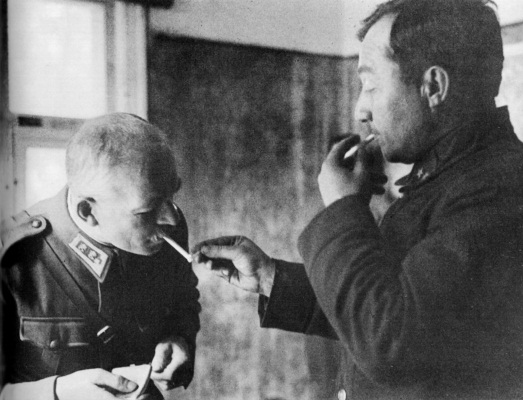<Back to Index>
- Lieutenant General of the Finnish Army Karl Lennart Oesch, 1892
PAGE SPONSOR


Karl Lennart Oesch (8 August 1892 – 28 March 1978) was one of the leading Finnish generals during World War II. He held a string of high staff assignments and front commands, and at the end of the Continuation War fully two - thirds of the Finnish ground forces were under his command. Oesch earned a reputation of being able to deal with difficult situations, a trait that Mannerheim used to the full.
Karl Lennart Oesch (he used Lennart as the first name, but is usually referred to as Karl Lennart or K.L.) was born to parents of Swiss origin, who had moved to Finland before his birth. Karl Lennart Oesch himself held a dual Finnish - Swiss citizenship until 1920. He attended school in Sortavala and studied in the Department of Mathematics and Physics in the University of Helsinki during 1911 - 1915.
Oesch joined the Jaeger Movement in 1915 and trained and fought in the Royal Prussian 27th Jäger Battalion. When the Jaegers returned to Finland in February 1918, he was commissioned a captain in the Finnish Army. During the Finnish Civil War Oesch commanded an infantry battalion.
In the 1920s and 1930s Oesch advanced rapidly in the Finnish Defense Forces. He studied in French military academies from 1923 to 1926 and, once he had returned in Finland, Oesch commanded the newly created general staff academy Sotakorkeakoulu during 1926 - 1929. In 1930 Oesch was promoted to Major General and appointed the Chief of the General Staff — assignment he was to hold almost a decade.
As Chief of the General Staff Oesch was one of the most influential men in the Finnish Defense Forces. He was a driving force behind the mobilization reform effected in the early 1930s (the new mobilization plans were mainly drafted by the then Lieutenant Colonel Aksel Airo). Oesch also served briefly as a deputy Minister of Interior Affairs in March 1932, during the crisis caused by the Mäntsälä rebellion. He was promoted to Lieutenant General in 1936.
When the Soviet invasion started the Winter War on 30 November 1939, Oesch continued as the Chief of the General Staff in the Finnish Supreme HQ under Mannerheim. Curiously enough, there's very little study of Oesch's role in the Supreme HQ, he is usually left in Mannerheim's and Airo's shadow.
Oesch got the opportunity to show his talents as front commander in March 1940. The Red Army had surprised Finns by crossing the frozen Bay of Viipuri and gained a foothold on its western shore. Mannerheim had created the Coast Group to repel the enemy, but its first commander Major General Kurt Martti Wallenius was dismissed in disgrace after holding the command only for three days. The situation was extremely critical, and Oesch was appointed to deal with it. Finnish defenses consisted mainly of badly equipped coastal defense battalions manned by older reservists and battalions hastily transferred from Lapland. Oesch was able to hold this motley and worn force together until the end of the war on 13 March 1940, causing heavy losses for the Red Army and significantly slowing its advance. Mannerheim began to regard Oesch as a man who can deal with difficult situations.
During the ensuing peace, known as the Interim Peace by Finns, Oesch first returned to his previous post as the Chief of the General Staff for a few weeks, until taking the command of II Army Corps in April 1940.
At the start of the Continuation War in June 1941 Oesch's army corps became the IV Army Corps. Its mission was to advance into southern Karelian Isthmus. But Mannerheim gave priority to Lieutenant General Erik Heinrichs’s Army of Karelia, which advanced into northern Karelia north of Lake Ladoga. Oesch did not get the permission to go into offensive until 20 August 1941, almost two months after the start of the war. Oesch and his chief of staff Colonel Valo Nihtilä decided to start the attack two days later.
Once the IV Army Corps's offensive started, it made rapid progress. But Oesch became over - stressed with work, and was forced to take a fortnight’s sick leave on 25 August 1941. However, on Nihtilä’s request Oesch returned already on 30 August 1941, as Oesch’s deputy Major General Taavetti Laatikainen neglected his new duties. On the previous day IV Army Corps's forces had entered Viipuri, the second largest city of pre - 1939 Finland. But Oesch’s greatest triumph was still to come.
In the last days of August 1941 Oesch’s forces closed elements of three Soviet divisions (43rd, 115th and 123rd Rifle Divisions) in a pocket in Porlampi, south of Viipuri. Although part of the Red Army troops were able to escape (leaving all their heavy equipment behind), on 1 September 1941 the remaining troops began to surrender. Finns took 9,325 POWs, among them commander of 43rd Rifle Division Major General Vladimir Kirpichnikov. Some 7,500 fallen Red Army soldiers were buried in the battlefield, and great booty taken. At the cost of less than 3,000 casualties, Oesch had won the greatest victory in Finland’s military history. However, around this time Oesch gave a controversial order that resulted in him being tried and condemned as a war criminal after the war.
In March 1942 Finnish forces were reorganized into three groups. Oesch was given the command of Olonets Group in the Olonets Isthmus between lakes Onega and Ladoga. Almost immediately in April 1942 he had to face a strong Soviet attack which was decisively beaten in ten days of battle. As the war progressed, it became increasingly clear Germany would lose the war, and the Finns had to find a way out. Oesch was preoccupied with planning the fortification and defense of his front, but kept a worried eye on the developments elsewhere.
The Red Army offensive in the Karelian Isthmus started on 9 June 1944, and broke through the Finnish main defense position on the next day. There was no unified command at place, and this was soon recognized as a serious flaw in the Finnish organization. On the morning of 14 June 1944 Oesch received a call from Lieutenant General Aksel Airo: "In the Isthmus everything is going to hell. Go get there on orders by the Commander - in - Chief, the army corps are yours. Laatikainen is somewhere around Viipuri." Oesch was given the title Commander of the Isthmus Forces, and a staff was gathered to serve under him. For the second time Oesch was sent to take over a critical part of the front, and this time it was the most critical ever. A decisive Soviet breakthrough in the Karelian Isthmus would probably have meant occupation and Finland becoming a Soviet satellite after the war.
Despite the loss of Viipuri on 20 June 1944, Oesch was able to pull the Finnish forces together. New divisions and brigades were sent to reinforce the Isthmus and Bay of Viipuri, and finally Oesch had under his command three army corps (III, IV and V), fully two thirds of the whole Finnish Army manpower. The triple defensive victories of Tali - Ihantala, Bay of Viipuri and Vuosalmi followed. Already during the Tali - Ihantala, Oesch had been awarded the coveted Mannerheim Cross on 26 June 1944. He remained Commander of the Isthmus Forces until October 1944, a month after the end of the Continuation War.
Oesch had a very impressive record during the war, but he felt that his achievements were not fully recognized. Mannerheim never promoted him a full general. Mannerheim recognized Oesch’s abilities, but Oesch was never one of his favorites. Mannerheim trusted most the men he himself had made, and Oesch, who had held very high posts already in peace time, was not one of them.
After the Continuation War Oesch’s career took a turn for the worse. After serving again as the Chief of the General Staff for almost a year, Oesch retired on his own will in September 1945. He was aware that the Soviets demanded his arrest as a war criminal. For a moment Oesch thought of escaping to Sweden, but in the end decided to stay and face the charges. He was arrested in the same month and later tried. Four years earlier, in September 1941, Oesch had given an order that permitted the guards to use their arms if POWs refused to follow orders. The details of the affair are not clear, but apparently some trigger - happy men took liberties with the orders, and a number of Soviet POWs were killed. Oesch stood accused for ordering the execution of 17 POWs.
According to Finnish sources, proof for Oesch’s personal responsibility for these deaths was rather dubious. But in the postwar political climate it was imperative to fulfill the Soviet demands in order not to give them any excuses to intervene even more in Finnish affairs. Oesch was condemned to 12 years of penal servitude by a Finnish military court on 19 July 1946, although the sentence was commuted to three years by the Highest Court on 2 February 1948. Nevertheless, Oesch’s military career was finished. Oesch was the only senior Finn to be condemned of war crimes.
After Oesch was released from the jail in February 1948 he devoted himself to military history, researching and writing extensively on Finnish experiences in World War II. His book of the battles of summer 1944 is still a valuable study on the subject. Oesch was also one of the founders and chief editor of a popular magazine on World War II Finnish history. He was made a Doc. Phil. honoris causa by the University of Turku in 1960. But when Oesch died in Helsinki on 28 March 1978, he was still embittered because he did not reach the rank of full general even in the post war years, when a number of retired officers were given honorary promotions in reserve.
Karl Lennart Oesch married Anna Niskanen and they had two children: son Karl Christian (born 1921) and daughter Ann - Mari (born 1922).

